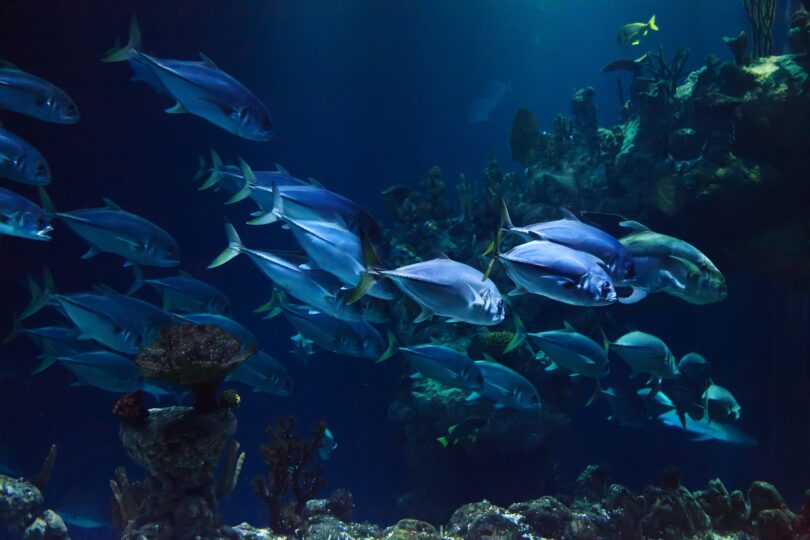Introduction:
Beneath the shimmering surface of our planet’s vast oceans, lakes, and rivers lies a realm teeming with life, where an astonishing array of creatures glide and dart through the aqueous depths. Among these aquatic denizens, fish stand out as some of the most diverse and captivating inhabitants, showcasing a myriad of adaptations and behaviors that have intrigued humans for centuries.
Diverse Habitats, Diverse Fish
From the sun-drenched coral reefs of the tropics to the icy depths of polar seas, fish have adapted to thrive in virtually every aquatic environment on Earth. In freshwater ecosystems, species like trout, salmon, and catfish dominate, each uniquely suited to their specific habitats, whether fast-flowing rivers or tranquil lakes. Meanwhile, the oceans harbor an even more staggering diversity, with everything from sleek, streamlined tuna racing through open waters to bizarre deep-sea creatures dwelling in perpetual darkness.
Adaptations for Survival
One of the most remarkable aspects of fish is their incredible array of adaptations, honed through millions of years of evolution. Take, for instance, the streamlined bodies of pelagic fish like swordfish and marlin, which allow them to slice effortlessly through the water with minimal resistance. Conversely, bottom-dwelling species such as flounders and anglerfish have flattened bodies and camouflage to blend seamlessly with their surroundings, while others, like the pufferfish, boast inflatable bodies as a defense mechanism against predators.
A Rainbow of Colors and Forms
Beyond their diverse habitats and adaptations, fish also dazzle with their kaleidoscopic colors and striking forms. From the electric hues of coral reef dwellers like parrotfish and angelfish to the intricate patterns of freshwater favorites like bettas and discus, the visual diversity of fish is simply breathtaking. Even within the same species, individuals may display variations in coloration and markings, influenced by factors such as age, sex, and environmental conditions.
Intriguing Behaviors
Fish are not just passive inhabitants of their watery world; they are also active participants in complex ecological interactions, displaying a wide range of behaviors that rival those of land-dwelling creatures. Schools of fish, for example, engage in synchronized swimming patterns that serve both as protection against predators and as a means of efficiently finding food. Some species, like the infamous piranha, are known for their aggressive feeding frenzies, while others, such as the clownfish, form intricate symbiotic relationships with anemones for mutual protection.
Challenges and Conservation
Despite their remarkable adaptability, fish face numerous threats in today’s world, ranging from habitat destruction and pollution to overfishing and climate change. Coral reefs, often referred to as the “rainforests of the sea,” are particularly vulnerable, with many species of fish dependent on these fragile ecosystems for their survival. Additionally, the illegal trade in exotic fish for aquariums poses a significant threat to certain species, driving them toward extinction in the wild.
A Call for Action
As stewards of our planet’s precious ecosystems, it is incumbent upon us to take action to protect and preserve the rich diversity of fish species that inhabit our waters. This entails implementing sustainable fishing practices, reducing pollution, and safeguarding critical habitats such as coral reefs and mangrove forests. Furthermore, raising awareness about the importance of conserving fish and their habitats is essential for inspiring collective action and fostering a deeper appreciation for these remarkable creatures.
An Ancient Lineage
Fish occupy a proud place in the evolutionary history of life on Earth, with their origins tracing back to the early Devonian period over 400 million years ago. From these ancient ancestors emerged a breathtaking diversity of forms, from the jawless lampreys and hagfish to the mighty cartilaginous sharks and the bony ray-finned fishes that dominate today’s aquatic ecosystems. Through the eons, fish have continually adapted and diversified, evolving an impressive array of anatomical, physiological, and behavioral traits to thrive in a wide range of environments.
Masters of Adaptation
One of the hallmarks of fish evolution is their unparalleled ability to adapt to diverse habitats and ecological niches. This adaptability is evident in the myriad forms and functions of fish anatomy, from the sleek, torpedo-like bodies of swift-swimming predators to the flattened shapes of bottom-dwelling species. Fish have also evolved an array of specialized sensory organs, including keen eyesight, sensitive lateral lines for detecting water movements, and elaborate chemosensory systems for detecting prey and navigating their environment.
Survival Strategies
To survive in the competitive world of aquatic ecosystems, fish have developed a plethora of ingenious strategies for finding food, avoiding predators, and reproducing. Some species, like the archerfish, have mastered the art of precision hunting, shooting down insects with jets of water expelled from their mouths. Others, like the clownfish, form intricate social structures within their host anemones, providing protection from predators and ensuring reproductive success. From elaborate courtship displays to cooperative hunting behaviors, the behavioral repertoire of fish is as diverse and fascinating as their physical adaptations.
Facing Modern Challenges
Despite their ancient lineage and remarkable adaptability, fish face unprecedented challenges in the modern era, driven primarily by human activities. Overfishing, habitat destruction, pollution, and climate change pose significant threats to fish populations worldwide, leading to declines in biodiversity and ecosystem health. Coral reefs, in particular, are under siege from multiple stressors, including rising sea temperatures, ocean acidification, and destructive fishing practices, endangering the countless species of fish and other marine life that depend on these vibrant ecosystems.
Towards a Sustainable Future
Addressing the challenges facing fish and their habitats requires concerted efforts at local, national, and global levels. Sustainable fisheries management, marine protected areas, pollution control measures, and climate change mitigation strategies are essential components of any comprehensive conservation plan. Public awareness and education also play a crucial role in fostering a deeper appreciation for fish and their ecological importance, inspiring individuals and communities to take action to protect these invaluable resources for future generations.
Conclusion
In the vast tapestry of life on Earth, fish occupy a unique and vital role, contributing to the health and balance of aquatic ecosystems around the globe. From their dazzling diversity of forms and colors to their fascinating behaviors and adaptations, fish continue to captivate and inspire us, serving as a poignant reminder of the intricate interconnectedness of all living things. As we navigate the challenges of the 21st century, let us pledge to safeguard the future of these enigmatic creatures, ensuring that they continue to swim freely in our oceans, lakes, and rivers for generations to come.






